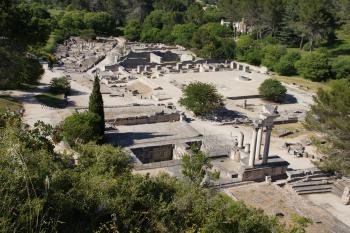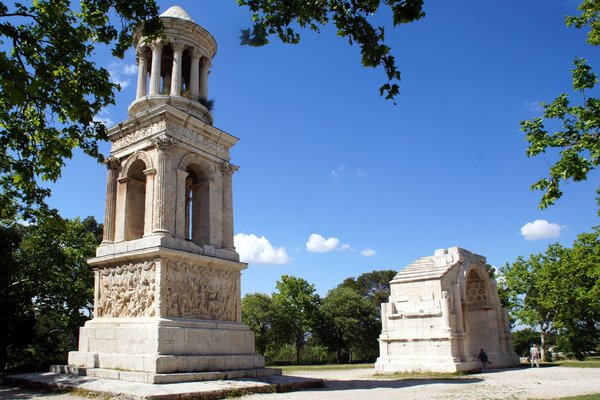France
Les villes antiques de la Narbonnaise
Les villes antiques de la Narbonnaise comprise urban monuments, remains of aqueducts and Roman roads in the region of the former Roman province of Narbonensis. In addition to the already inscribed Arles and Nîmes, which have a separate TWHS entry, Glanum is the most important component of this serial proposal. The archaeological site of Glanum consists of the ruins of the Roman city centre and two well preserved monuments outside the ancient city walls: a triumphal arch and the Mausoleum of the Julii.
Site Info
Official Information
- Full Name
- Les villes antiques de la Narbonnaise et leur territoire: Nimes, Arles, Glanum, aqueducs, via Domitia (ID: 1658)
- Country
- France
- Status
-
On tentative list 2002
Site history
History of Les villes antiques de la Narbonnaise
- 2002: Added to Tentative List
- Added to tentative list
- Type
- Cultural
- Criteria
Links
- UNESCO
- whc.unesco.org
All Links
UNESCO.org
- whc.unesco.org — whc.unesco.org
Community Information
- Community Category
- Archaeological site: Ancient Rome
Travel Information
Recent Connections
News
No news.
Recent Visitors
Visitors of Les villes antiques de la Narbonnaise
- Aitia
- Alexander Lehmann
- alicemears
- Ammon Watkins
- Argo
- Astraftis
- basementonline
- BaziFettehenne
- bossc
- Bropyk
- butterflybird
- Caspar
- Christian Wagner
- Christoph
- Christravelblog
- Clyde
- Coppi
- ctravel
- CugelVance
- Dani Cyr
- Daniela Hohmann
- Daniel Chazad
- Daniel Gabi
- Daniel R-F
- David Aaronson
- David Berlanda
- Dimitar Krastev
- Dwight Zehuan Xiao
- Echwel
- Els Slots
- erdsaumnaht
- Erik Jelinek
- Evgenii
- Fam39
- Farinelli
- Feldhase
- Femke Roos
- Flexiear
- Francky D'Hoop
- FrankW
- George Gdanski
- GeorgeIng61
- Gilles
- Hadrianus
- HaraldOest
- Hasco
- Hubert
- Ian Cade
- Ilya Burlak
- Jana and Matt
- Jan-Willem
- Jarek Pokrzywnicki
- Javier Coro
- Jeffrey Chai
- Joel on the Road
- Jonas Kremer
- jonathanfr
- Krzysztof B
- kutasp
- Lara Adler
- Lucas Del Puppo
- Marcobrey
- Matejicek
- Mathijs
- MAURO PODDA PANI
- MaxHeAnouBen
- MH
- M. Huineman
- michaelsballard
- Monica Tasciotti
- MoPython
- Patrik
- Paul Schofield
- Persian Globetrotter
- Philipp Peterer
- Pink Bunny
- Reisedachs
- RobRos
- Roel Sterken
- Roger Ourset
- Roman Bruehwiler
- Sclowitz
- Sergio Arjona
- Shijie ZHU
- SirLoydd
- Solivagant
- Squiffy
- Stefan A. Michelfeit
- stephanvermeulen
- Szucs Tamas
- Tcchang0825
- Tevity
- Thomas Buechler
- Thomas van der Walt
- Tim Allen
- tony0001
- Tsunami
- Vanessa Buechler
- V&M
- voyager
- WalGra
- Walter
- WILLIAM RICH
- Wojciech Fedoruk
- Wo_ko
- Xiquinho Silva
Community Reviews
Show full reviewsHubert
Les villes antiques de la Narbonnaise
Les villes antiques de la Narbonnaise (On tentative list)

The very short description on the WHC website provides little information which sites the nomination comprises, but Arles, Nîmes and Glanum seem to be the most important. The Roman remains in Arles are already inscribed and Nîmes has a separate T-list entry, so this review is on our visit of the archaeological site of Glanum. It is located at the foot of the Alpilles mountain range, one kilometre south of Saint-Rémy-de-Provence and about 30 minutes from Arles by car.
The best-known monuments are 'Les Antiques': the Mausoleum of the Julii, 18 meters high, with well-preserved reliefs and next to it a triumphal arch, which has a strange shape, because the upper part is missing. Both are outside the Roman town, close to the car park and can be visited without charge. Just across the street is the entrance to the Roman town of Glanum (7.50 euro entrance fee).
The city was founded by the Salyens, was under Hellenistic influence and became a Roman colony about 30 BC until its destruction in the year 260 AD. The excavated area is about 300 metres in length and 80 metres in width. You can visit the remains of residential houses, public and religious buildings. The northern part comprises the residential quarter with the forum, public baths, a fountain and the remains of several residences, e.g. the House of Antae where some columns and a water basin were preserved. In the southern part are the remains of a temple, a chapel and a sacred …
Keep reading 0 comments
